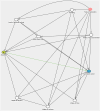Pre-diagnostic 25-hydroxyvitamin D levels and subsite-specific colorectal cancer risk: a nested case-control study from the Norwegian Women and Cancer Study (NOWAC)
- PMID: 39749802
- PMCID: PMC11946035
- DOI: 10.1017/S0007114524003350
Pre-diagnostic 25-hydroxyvitamin D levels and subsite-specific colorectal cancer risk: a nested case-control study from the Norwegian Women and Cancer Study (NOWAC)
Abstract
Colorectal cancer (CRC), the third most common cancer globally, causes over 900 000 deaths annually. Although vitamin D is observed to have potential anti-carcinogenic properties, research findings on its preventable effect against CRC remain inconclusive. Notably, different subsites within the colon and rectum may be associated with distinct risk factors. While some studies have explored this relationship with circulating 25-hydroxyvitamin D (25(OH)D), the results remain contradictory. Our study employed a nested case-control design, involving 775 CRC cases matched with 775 cancer-free controls based on age, region of living and the time of blood sampling. The study was conducted within the Norwegian Women and Cancer post-genome cohort, which comprises approximately 50 000 women. We measured pre-diagnostic circulating plasma 25(OH)D status 5-13 years before diagnosis. Adjustment variables were based on self-administered questionnaires and included BMI, physical activity level, smoking, intake of processed meat, calcium, alcohol and fibre. An increase of 5 nmol/l in 25(OH)D reduced the risk of proximal colon cancer by 6 % (OR = 0·94, 95 % CI 0·89, 0·99). Furthermore, a sensitivity analysis revealed a 62 % increased risk among the women with 25(OH)D levels below 50 nmol/l compared with sufficient levels, ≥ 50 to < 75 nmol/l (OR = 1·62, 95 % CI 1·01, 2·61). No association was found with CRC, colon or distal colon cancer. We observed a subsite-specific association between 25(OH)D and CRC, highlighting the need for further investigation to elucidate the potential underlying mechanisms and clinical implications.
Keywords: 25-hydroxyvitamin D; Colorectal cancer; Distal colon cancer; Proximal colon cancer; Vitamin D.
Figures


Similar articles
-
Pre-diagnostic intake of vitamin D and incidence of colorectal cancer by anatomical subsites: the Norwegian Women and Cancer Cohort Study (NOWAC).Br J Nutr. 2023 Sep 28;130(6):1047-1055. doi: 10.1017/S0007114523000077. Epub 2023 Jan 9. Br J Nutr. 2023. PMID: 36620946 Free PMC article.
-
Meat intake, cooking methods and risk of proximal colon, distal colon and rectal cancer: the Norwegian Women and Cancer (NOWAC) cohort study.Int J Cancer. 2013 Sep 1;133(5):1153-63. doi: 10.1002/ijc.28101. Epub 2013 Mar 29. Int J Cancer. 2013. PMID: 23401013
-
Vitamin D and Vitamin D-binding protein and risk of bladder cancer: A nested case-control study in the Norwegian Janus Serum Bank Cohort.Cancer Med. 2021 Jun;10(12):4107-4116. doi: 10.1002/cam4.3960. Epub 2021 Jun 3. Cancer Med. 2021. PMID: 34080787 Free PMC article.
-
Additively protective effects of vitamin D and calcium against colorectal adenoma incidence, malignant transformation and progression: A systematic review and meta-analysis.Clin Nutr. 2020 Aug;39(8):2525-2538. doi: 10.1016/j.clnu.2019.11.012. Epub 2019 Nov 16. Clin Nutr. 2020. PMID: 31784301
-
Low circulating 25-hydroxyvitamin D level is associated with increased colorectal cancer mortality: a systematic review and dose-response meta-analysis.Biosci Rep. 2020 Jul 31;40(7):BSR20201008. doi: 10.1042/BSR20201008. Biosci Rep. 2020. PMID: 32686830 Free PMC article.
References
-
- Feldman D, Krishnan AV, Swami S, et al. (2014) The role of vitamin D in reducing cancer risk and progression. Nat Rev Cancer 14, 342–357. - PubMed
LinkOut - more resources
Full Text Sources

